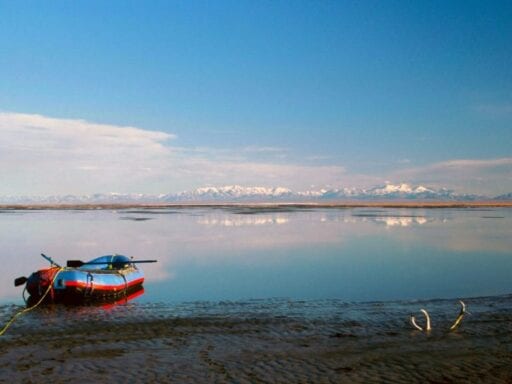The Interior Department is moving ahead with oil and gas permitting in the Arctic National Wildlife Refuge.
As the partial government shutdown stretches on and on, leaving piles of garbage in national parks to grow and scientific experiments in limbo, the Interior Department is deploying its staff to advance fossil fuel extraction on public lands.
The Bureau of Land Management, the office at Interior that handles permitting for oil and gas on 700 million acres of public lands, is closed for the shutdown. Yet it’s still continuing its work on permitting mining and drilling, as Elizabeth Harball at Alaska’s Energy Desk first reported Friday.
Harball reported that Interior is still scheduling meetings and conducting its environmental review for drilling in the Arctic National Wildlife Refuge:
Emails obtained by Alaska’s Energy Desk show that on Jan. 3 — 13 days into the shutdown — Bureau of Land Management project coordinator Nicole Hayes wrote to community leaders in Alaska to schedule public meetings for the ongoing environmental review process needed to allow oil lease sales in the Arctic refuge.
When contacted Friday by Alaska’s Energy Desk, Hayes’ email account sent an automatic reply: “Due to the lapse in funding of the federal government budget, I am out of the office. I am not authorized to work during this time, but will respond to your email when I return to the office.”
Interior is also moving ahead with the review process for oil and gas development in the National Petroleum Reserve Alaska using leftover funds from the prior fiscal year.
A former BLM staffer told Harball that it’s unusual to continue advancing the permitting process during a government shutdown.
Rep. Raúl Grijalva (D-AZ), the incoming chair of the House Committee on Natural Resources, which has oversight of Interior, wrote a letter on Monday to acting Interior Secretary David Bernhardt questioning why the review process for drilling in ANWR is continuing during the government shutdown.
“Asking people to comment on two major development processes in the Arctic with huge potential environmental and human consequences with anyone in the agency able to answer questions defeats the purpose of the public participation process, and gives the strong impression that BLM is simply trying to check the boxes and end the comment periods as soon as possible, not engage in a meaningful dialogue with impacted communities or stakeholders,” Grijalva wrote in the letter.
On the industry side, one official said day-to-day work with BLM hasn’t been hampered.
“To this point, we have not seen any major effects of the shutdown on our industry,” said Mike Sommers, the president and CEO of the American Petroleum Institute, on a conference call with reporters on Tuesday. “Many of the things that we deal with are fee-based.”
According to BLM’s shutdown contingency plan, employees who work on “permit activities for which the Bureau charges a processing fee” are still expected to continue working because those fees pay for their work.
It’s not too surprising that Interior is still trying to advance the ball for fossil fuels even during the government shutdown. Former Interior Secretary Ryan Zinke, who resigned in early January amid numerous alleged ethics violations, made industry interests a priority for the agency. He presided over the largest rollback of federal land protections in US history, started the process of opening nearly all US coastal waters to drilling, and chipped away at environmental regulations like the Endangered Species Act.
The United States is now the largest crude oil producer and the largest natural gas producer in the world. The surge in production has helped drive down energy costs. President Trump himself also took credit for low gas prices, so the administration has a strong incentive to increase the flow of oil and gas.
But what’s particularly striking about BLM’s work on oil lease sales during the shutdown is that many other staff in other divisions of Interior responsible for environmental and science work have been furloughed. The US Geological Survey at Interior furloughed 99 percent of its more than 8,000 employees. The US Fish and Wildlife Service furloughed 84 percent of its workforce. About half of the 800-person staff in the Bureau of Safety and Environmental Enforcement is offline.
To prevent further damage, Joshua Tree National Park will close to all visitors Thursday as the shutdown drags on. Unsupervised visitors have already created new roads through the desert and defaced its namesake Joshua trees, a park spokesman says https://t.co/LiOvIorS9i
— Corbin Hiar (@CorbinHiar) January 8, 2019
“It’s not just the gap [in data collection],” former Interior Secretary Sally Jewell, who served under the Obama administration during the 16-day shutdown in 2013, told the New York Times. “It’s the ability to correlate that with a broader picture of what’s happening environmentally and ecologically. It really does mess things up.”
Interior’s eight Climate Adaptation Science Centers, which work across the country to collect and implement climate research, are also offline. It’s starting to impair work with universities and states on climate adaptation, according to one researcher.
“It’s like having one spouse doing all of the work in a marriage,” Renee McPherson, a meteorologist and university director of the South Central CASC at the University of Oklahoma, told E&E News. “That may work for a week or so, but it’s no way to operate a team.”
Author: Umair Irfan
Read More



